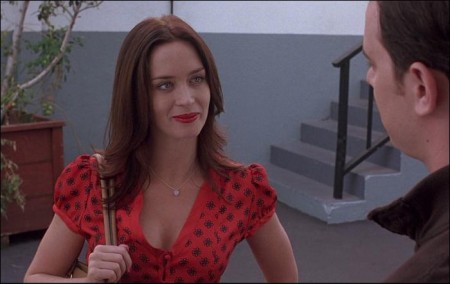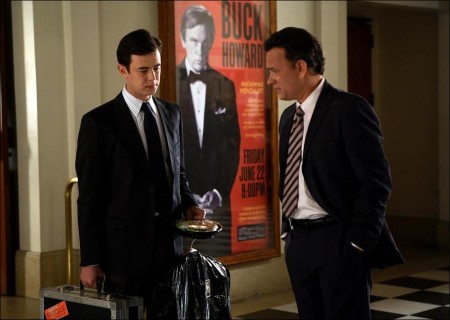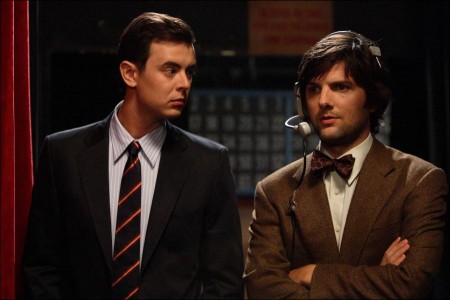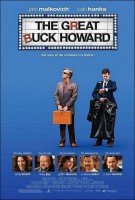About the Film
The Great Buck Howard is a comedy about two seemingly disparate people, mentalist Buck Howard and his long suffering assistant Troy. The path they take together is often surreal, populated by a hilarious cast of characters, beginning with the great mentalist, Buck Howard himself.
Writer-director Sean McGinly had some experience in this world. He explains, “I went to law school like Troy and quit very soon after arriving. I cashed out my student loan and moved to LA, not knowing anyone or anything. I was completely clueless. I hadn’t written anything. I wasn’t some child prodigy. It was a ridiculous thing to do. So I had a succession of weird Hollywood type jobs where I met different kinds of strange characters, some who were on the fringes of the entertainment business.”
The heart of the story, he explains, is the notion that it is never too late to reshape one’s life. “Buck and Troy meet each other at a crucial time. While Buck is not necessarily Troy’s idea of creative success, at least Buck has passion and talent. Troy learns that it’s possible to live life loving what you do,” says McGinly. “As for Buck, he strives to hit the big time again, landing that gig in Vegas and being a guest on The Tonight Show with Jay Leno. What Buck doesn’t realize is that he’s already living his dream.”
McGinly’s offbeat, funny tale appealed to Colin Hanks. The star explains, “My agent had sent me a bunch of scripts, so THE GREAT BUCK HOWARD was in a big pile. The ADD child in me just forgot about them. Then my agent called and asked if I had gotten through the pile. When I sheepishly said ‘No’ he asked me to start with THE GREAT BUCK HOWARD knowing that I would like it. Like it? I loved it! Opened up the first page, couldn’t put it down, finished it, called my agent back and asked him to set up a meeting with Sean,” he says.
He gave it to producer Gary Goetzman, who fell in love with it and passed it on to producing partner Tom Hanks, who was equally excited by the project. Playtone, Hanks and Goetzman’s company, signed on to produce the movie.
Sean McGinly was thrilled with the prospect of Colin Hanks portraying Troy. McGinly knew that he could convey the script’s comedy and drama, as well as Troy’s innocence, confusion and wry humor. McGinly says, “I needed an actor that could handle both the humor and drama. After seeing Orange County, I knew Colin was the right choice for this part. It was probably a couple of years between his agreeing to star in the movie and the movie getting made. So we had a lot of time to talk about the character. Colin was involved in all the auditions, so by the time we started shooting, he was the character.”
The next mission for the filmmakers was to cast Buck Howard. “When John walked into the make-up test for the first time dressed as Buck Howard, honestly, tears almost came to my eyes. He just looked so much like I had imagined Buck. We start taking some Buck Howard stills and John did all these poses and weird smiles. And I realized that he really got it. After that moment, I knew he was going to be fantastic as Buck Howard,” says McGinly.
As with Colin Hanks, the screenplay brought Malkovich to the project. “The script was sent to me and I read it fairly quickly. I liked it very much. I thought it was very funny and very observant and it looked as if Buck Howard would be an enormous pleasure to play, which he was. So, it didn’t really take much to convince me.”
Producer Goetzman adds, “I think John gravitated to the material and saw Buck Howard as somebody that we all kind of know, or at least understand to some degree. Buck behaves outrageously, but John succeeded in making him very human, tragically funny, and someone we can relate to.”
Hanks was thrilled at the chance to work opposite screen legend John Malkovich. “John has an aura about him that I always saw as a big mystery. Not only is John a great actor, he is also great fun to work with,” says Colin Hanks.
Both actors equally enjoyed working with Sean McGinly. Malkovich explains, “Sean is clearly not a control freak. I think he likes to push you to the boundaries of things, and see what’s underneath or stuck up on a shelf somewhere. He essentially likes to see what happens. We generally did the scene as written, but he let us riff on it too. Sean is very attuned to performance.”
At the beginning of the film, Troy leaves law school and a life of stability only to discover himself adrift in a strange city, with amorphous aspirations and no real friends or family. Buck Howard is similarly solo and rootless, albeit for different reasons: his life as a performer on the road has taken him from city to city for years. When these two meet, they find temporary common ground – both are working for the care, succor and promotion of Buck Howard. Buck considers himself a celebrity even though his fame is long gone. He gravitates to pockets of small-town America, where he is still well-liked and fondly, if vaguely, remembered. Troy soon realizes that his job is to shield Buck from the crueler facts of his life.
“A lot of Troy’s job is to just maintain the illusion for Buck. To shelter Buck from the cold reality that he is no longer a big name,” says Malkovich.
Their friendship begins to fall apart when young, aggressive, very attractive PR woman Valerie Brennan joins Buck and Troy on the road. Actress Emily Blunt portrays Valerie. “Valerie is an ambitious woman who can’t quite believe she has been assigned to work with this has-been instead of Tom Cruise or someone equally as exciting,” says Blunt.
Still Valerie and Troy begin to form their own bond, essentially based on their mutual attraction. “These two are quite an unlikely couple. They are both stuck in this situation which is frustrating, to say the least. And, although they are very different, they find this connection,” says Blunt.
A connection that doesn’t thrill Buck as he finds he is no longer the center of their attention. Producer Goetzman explains, “Buck’s character is like that of anyone who strives for fame. No matter how famous you are, no matter how much money, love, or adoration you receive, it is never enough.”
Helping to create a distinctive look for Buck Howard was costume designer Johnetta Boone, “I was so excited to get the call about this movie because it finally gave me the opportunity to do eclectic designing as opposed to your general corporate contemporary classic sort of look.”
And, Buck Howard’s costumes are eclectic. John Malkovich explains, “It’s kind of Ben Sherman in his twilight years, the Beverly Hills ‘I worked with Freddie Fields’ kind of look – pastels, oranges, monochromatic shirts and ties.”
Everyday, the crew eagerly anticipated Buck’s new outrageous outfit, perhaps an orange sport coat with a brown silk shiny shirt and a paisley tie?
Boone adds, “I did a play on patterns, a play on colors. Since there were very few rules, I put some florals together with mixed stripes, or added some solid colors that are probably too bold for your average gentleman.”
Clothing was only one aspect of creating Buck Howard. Hair and make-up also played an integral part.
Jokes Malkovich, “Well, the make-up and hair took a change when Buck has a little wave of popularity and prosperity again. I decided to have him have a facelift, a ‘hipper’ hairstyle and some dermabrasion. It was very, very successful.”
Producer Goetzman chimes in, “Buck’s wardrobe has a very unique style. Sharp, contemporary, retro, all at the same time.”
A stellar, award-winning behind-the-scenes crew helped McGinly bring his vision to screen.
“It was amazing,” says McGinly. “First off, working with director of photography Tak Fujimoto was a dream. It was fantastic to work with someone of that stature. Our production designer Gary Fruktoff had worked on Orange County and was already part of the Playtone family. Essentially, Playtone has this incredible roster of amazing people, from which I completely benefited.”
Mentalism vs. Magic
A practitioner of mentalism uses mental acuity, principals of stage magic and/or suggestion to present the illusion of mind reading or mind control. At their first meeting, when Troy mistakes Buck for a magician, Buck speedily corrects him, “I was a magician when I was 3 years old, but I evolved out of that. Not that I have anything against magicians, as long as they’re dead.”
The subtle differences between mentalism and magic eluded the filmmakers and actors too. Malkovich jokes, “Buck is a so-called mentalist performer, who does some kind of supposed mind reading and various things … well, not really mind reading, but I suppose some kind of mental suggestion, which I hear was once very popular.”
Colin Hanks didn’t really have a better handle on the art of the “mentalist” either. “Before we made the film, I didn’t really know there was a difference between mentalism and magic. During the film, I sort of got what the fine line is. Now that we’re done, to be perfectly honest, it is still a bit gray.”
For McGinly, the distinction between mentalist and magician is moot; he notes that Buck Howard’s greatest feat, ultimately, was realizing his true dream. “What I learned from the crazy characters I met when I first came to Hollywood and in making this film is that there is real satisfaction and fulfillment in understanding and following your heart. I certainly got to do this on this film – for me, that was magic.”
About the Amazing Kreskin
With a showman’s flair, a comedian’s wit, and the capacities of a bona fide Mentalist or thought reader, The Amazing Kreskin has, for some six decades, dramatized the unique facets of the human mind…his own. His very name has become an integral part of pop culture throughout the world, invoked in comedy clubs, comic strips, print stories, and TV shows from sitcoms on through national magazines.
Born in Montclair, New Jersey, it was during the childhood game “hot and cold” that Kreskin’s remarkable ability to find hidden objects emerged. His ability to read thoughts expanded, and by his teens he also became nationally recognized in the United States as “The World’s Youngest Hypnotist,” resulting in his collaborating in psychological clinical studies extending into the realm of Parapsychology and the Power of Suggestion.
By his late teens, this icon of thought transference developed a mental test that has become the highlight of his performances all over the world. This signature piece has Kreskin requesting that his check be hidden somewhere within the venue he is appearing. If he fails to find it, he will forfeit his fee.
Through the decades, audiences of all ages have been drawn to this legendary figure. How many other celebrities can boast their own television series, their own board game, over some sixteen books, their own theme song arranged by the renowned Skitch Henderson at Carnegie Hall, let alone hundreds of appearances on almost every talk/variety show to be had. His performances have been seen all over the world, and he has flown over 3 million miles.
The Amazing Kreskin has also become a training consultant to law enforcement and security personnel throughout the western world in the development in their own powers of observation and intuitive skills.
Kreskin continues to offer “$50,000 to anybody that can prove that he employs paid secret assistants or confederates in any phase of his program”. It is an offer that he has held for many, many years.
Finally, through the years, Kreskin has received international recognition for extraordinary predictions often dealing with world affairs. Regarding the US Presidential Election in 2008, he logged the results with a written statement made 11 months earlier, on December 6, 2007. In the year 2008 on FOX Business News, he predicted the results of the Super Bowl three days before the game.
A few years earlier in Canada, one month before a national election, he predicted the re-election of Prime Minister Martin, and named the exact amount of seats he would carry. On the day after the election, on National Canadian Television, he reflected that the government could collapse in 14 months. He was off by 5 days. He has been called by many the Nostradamus of the twentieth century.
Production notes provided by Magnolia Pictures.
The Great Buck Howard
Starring: Tom Hanks, Emily Blunt, Steve Zahn, Matthew Gray Gubler, John Malkovich, Colin Hanks
Directed by: Sean McGinly
Screenplay by: Sean McGinly
Release Date: March 20th, 2009
MPAA Rating: PG some language including suggestive remarks, and a drug reference.
Studio: Magnolia Pictures
Box Office Totals
Domestic: $750,587 (95.0%)
Foreign: $39,608 (5.0%)
Total: $790,195 (Worldwide)





